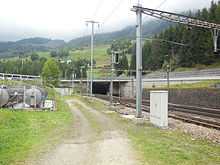Gotthard Tunnel





The Gotthard Tunnel (German: Gotthardtunnel, Italian: Galleria del San Gottardo) is a 15.003 km (9.322 mi) long railway tunnel and forms the summit of the Gotthard Railway in Switzerland. It connects Göschenen with Airolo and was the first tunnel through the Gotthard massif. It is built as one double-track, standard gauge tunnel.[2]
The tunnel rises from the northern portal at Göschenen (1106 metres / 3650 ft) and the highest point (1151 metres, or 3800 ft) is reached after approximately 8 kilometres (5 mi). After two more kilometers, the border between the cantons of Uri and Ticino is passed; after another 5 kilometres (3 mi), the tunnel ends at the southern portal near to Airolo (1142 metres, or 3770 ft). The trip takes about seven to eight minutes by train. Services are operated by the Swiss Federal Railways.
Construction
The tunnel was built from 1871 to 1881. Construction was surveyed by the Swiss engineer Louis Favre, who suffered a fatal heart attack inside the tunnel in 1879. Construction was difficult due to financial, technical and geological issues, the last leading to the death of around 200 workers (the exact number is not known) mainly due to water inrushes; many were also killed by the compressed air-driven trains carrying excavated material out of the tunnel. There were also serious health issues caused by an epidemic of hookworm infection.[3] A strike of the workers in 1875 was crushed by the Swiss Army, killing four and wounding 13.
There is a memorial for the dead workers near the station building at Airolo, created by the artist Vincenzo Vela.
Operation
The tunnel was opened for traffic in 1882, operated by the private railway company Gotthardbahn, which ran from Lucerne to Chiasso at the Italian border. The Gotthardbahn was integrated into the Swiss Federal Railways in 1909. In 1920, the first electric trains were run through the Gotthard Tunnel. Initially the voltage had to be reduced from the desired 15 kilovolts to 7.5 kV, because the grime deposited on the insulators by the steam locomotives encouraged excessive arcing. However, in May the next year, steam was replaced entirely by electric traction, and the problem of soot and grime was eliminated.[4]
Until the opening of the Gotthard Road Tunnel, the Swiss Federal Railways offered piggyback services for cars and trucks through the Gotthard Tunnel. Today, that service exists as the rolling highway from the German to the Italian border and aims to reduce truck traffic on Swiss expressways. An improvisational piggyback service from Göschenen to Airolo was offered during the two-month closure of the Gotthard Road Tunnel in 2001.
Neighbouring tunnels
The nearby Gotthard Road Tunnel was opened in 1980. A second railway tunnel, the Gotthard Base Tunnel, is currently under construction with completion now expected in 2016, having broken through in 2010.[5] The adjacent ramps include several turn tunnels (see Table of turn tunnels).
See also
References
| Wikimedia Commons has media related to Gotthard rail tunnel. |
- ↑ Braun, Adolphe: Photographische Ansichten der Gotthardbahn, Dornach im Elsass, ca. 1875
- ↑ Eisenbahnatlas Schweiz. Verlag Schweers + Wall GmbH. 2012. p. 34. ISBN 978-3-89494-130-7.
- ↑ Bibliography of Hookworm Disease
- ↑ Book: "Die Bahn durch den Gotthard"
- ↑ BBC News - Swiss complete world's longest tunnel
External links
- A map with the locations of Gotthard Rail Tunnel and Gotthard Base Tunnel
- Gotthard Tunnel. Information about Gotthard Tunnel (German)
This article includes a list of references, related reading or external links, but its sources remain unclear because it lacks inline citations. Please improve this article by introducing more precise citations.
| |||||||||